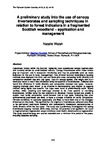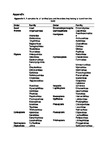A preliminary study into the use of canopy invertebrates and sampling techniques in relation to forest indicators in a fragmented Scottish woodland – application and management
| dc.contributor.author | Walsh, N. | |
| dc.date.accessioned | 2019-05-15T13:09:19Z | |
| dc.date.available | 2019-05-15T13:09:19Z | |
| dc.date.issued | 2012 | |
| dc.identifier.citation |
Walsh, N. (2012) 'A preliminary study into the use of canopy invertebrates and sampling techniques in relation to forest indicators in a fragmented Scottish woodland – application and management', The Plymouth Student Scientist, 5(2), p. 44-79. | en_US |
| dc.identifier.issn | 1754-2383 | |
| dc.identifier.uri | http://hdl.handle.net/10026.1/13983 | |
| dc.description.abstract |
Caledonian forests within the Scottish Highlands have experienced severe fragmentation and currently remain as small isolated habitats. Canopy invertebrates within these forests play an important role in ecosystem functioning and may be potentially used as forest indicators for the use in forest management. Four different low-cost invertebrate trapping methods were deployed into birch, oak and Scots pine trees, comparing family diversity and composition between tree and trap types. Data on canopy spread, tree height and d.b.h were also tested to see if they influenced family composition of invertebrates. Collected data found little difference in family diversity and composition between tree types. However, trapping methods were shown to be effective in demonstrating taxa relation to trapping method, being highly taxa specific. Fan traps were found to predominantly catch Diptera families, whilst thrashing and bark-traps showed to be more specific to non-flying invertebrates, families using the tree substrate for dispersal. Canopy spread was unable to explain most family composition found between tree or trap types, indicating that other environmental parameters are likely to have a stronger influence on family composition. Climatic conditions, in particular seasonality, are likely to have been one of the strongest influences on this study. This signified that the majority of invertebrates collected were likely to be permanent year-round residents and consequently inadequate representatives of family diversity within the tree types. This study was a preliminary investigation into testing invertebrate trapping methods within trees, and has the potential to be applied in the future to fragmented and regeneration areas to indicate forest health, deterioration or regeneration. This study should be long-term and be extended over a minimum time period of five years, including seasonal sampling. | en_US |
| dc.language.iso | en | en_US |
| dc.publisher | University of Plymouth | |
| dc.rights | Attribution 3.0 United States | * |
| dc.rights.uri | http://creativecommons.org/licenses/by/3.0/us/ | * |
| dc.subject | Caledonian forests | en_US |
| dc.subject | Scottish Highlands | en_US |
| dc.subject | fragmentation | en_US |
| dc.subject | ecosystem | en_US |
| dc.subject | canopy invertebrates | en_US |
| dc.subject | canopy | en_US |
| dc.subject | trees | en_US |
| dc.subject | birch | en_US |
| dc.subject | oak | en_US |
| dc.subject | Scots pine | en_US |
| dc.title | A preliminary study into the use of canopy invertebrates and sampling techniques in relation to forest indicators in a fragmented Scottish woodland – application and management | en_US |
| dc.type | Article | |
| plymouth.issue | 2 | |
| plymouth.volume | 5 | |
| plymouth.journal | The Plymouth Student Scientist |




